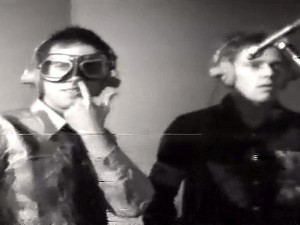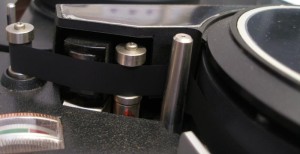Glitch aesthetics
In an article on the BBC website Temple reflected on the recordings: ‘we affectionately called the format “Glorious Bogroll Vision” but really it was murksville. Today monochrome footage would be perfectly graded with high-contrast effects. But the 1970s format has a dropout-ridden, glitchy feel which I enjoy now.’

Note the visible drop out in the image
The glitches of 1/2″ video were perfect for Temple’s film, which aimed to capture the apocalyptic feeling of Britain on the eve of 1977. Indeed, Temple reveals that ‘we cut in a couple of extra glitches we liked them so much.‘
Does the cutting in of additional imperfection signal a kind-of fetishisation of the analogue video, a form of wanton nostalgia that enables only a self-referential wallowing on a time when things were gloriously a lot worse than they are now?
Perhaps the corrupted image interrupts the enhanced definition and clarity of contemporary digital video.
Indeed, Temple’s film demonstrates how visual perception is always produced by the transmission devices that playback moving images, sound and images, whether that be the 1/2″ video tape or the super HD television.
It is reminder, in other words, that there are always other ways of seeing, and underlines how punk, as a mode of aesthetic address in this case, maintains its capacity to intervene into the business-as-usual ordering of reality.
What to do with your 1/2″ video tapes?

While Temple’s film was made to look worse than it could have been, EIAJ 1/2″ video tapes are most definitely a vulnerable format and action therefore needs to be taken if they are to be preserved effectively.
In a week where the British Library launched their Save Our Sounds campaign, which stated that ‘archival consensus internationally is that we have approximately 15 years in which to save our sound collections by digitising them before they become unreadable and are effectively lost,’ the same timeframes should be applied to magnetic tape-based video collections.
So if your 1/2″ tapes are rotting in your shed as Temple’s Clash footage was, you know that you need to get in there, fish them out, and send them to us pronto!


